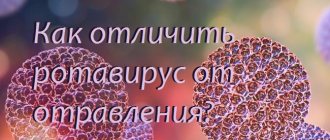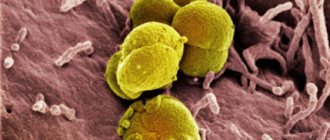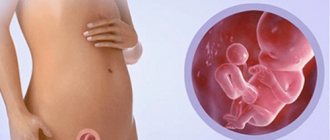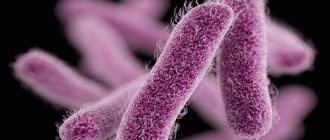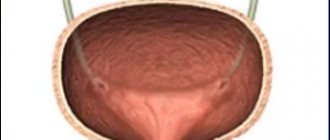During pregnancy, the expectant mother's immunity weakens. For this reason, when contacting any viruses and bacteria, the risk of contracting various ailments increases. Often pregnant women become infected with rotavirus, an infection that affects the gastrointestinal tract and disrupts its functioning.
Another name for rotavirus is intestinal flu. It is accompanied by unpleasant symptoms, but is quite easy to treat even in pregnant women.
The effect of rotavirus on pregnancy
Rotavirus is a member of the Reoviridae family. It has double-stranded RNA surrounded by a protein shell. It is very well preserved in the external environment and is very resistant to low temperatures. Sanitary measures taken against other viruses and bacteria are not sufficient to affect rotavirus, so the incidence rate still remains high.
How dangerous is rotavirus in the early stages?
The main danger is the possible development of congenital pathologies.
The disease suffered from 7 to 11 weeks can lead to an increased risk of the following complications:
- fetal hypoxia;
- placental abruption;
- development of intrauterine infection.
The risk of developing these conditions due to infection is extremely low.
The danger of rotavirus in later stages
Carefully! If the infection develops in the last weeks of pregnancy (38,39), there is always a risk of labor complications. When a child passes through the birth canal, he can also become infected from a sick mother. During the neonatal period, the disease is very severe and requires qualified medical care, so discharge from the maternity hospital can be greatly delayed.
Consequences for the child
Often, they are missing.
However, severe disease can lead to the following problems:
- hypoxia;
- developmental delay;
- increased risk of intrauterine infections.
If signs of infection appear, you should immediately seek help from a doctor. This will significantly reduce the risk of possible complications.
Be careful with home methods
Stomach flu and pregnancy
Rotavirus infection is popularly called intestinal flu. The disease in medicine is actually considered an infection that initially enters the intestines, causing vomiting, especially when taking dairy products.
It is believed that within 5 days the body is able to cope with the disease on its own, but in some situations emergency medical care will be required.
Rotavirus: definition
The causative agent of rotavirus infection, intestinal influenza, belongs to the family “Reoviridae”, genus “Rotavirus”. The definition - rotavirus received thanks to the decoding of “rota” in Latin - wheel, for the reason that viral particles under a microscope are visible in the form of wheels with a sleeve. The dimensions of such particles are 65-75 m and contain RNA.
Based on antigenic properties, they are divided into nine serological types, of which only 4 types, the rest are isolated from animals.
Routes of infection with rotavirus
The spread of rotavirus on the planet occurs regardless of the region, air humidity and climate, and therefore infection and infection with such a disease is observed in almost every corner. You can get sick not only by contacting someone who is sick, but also by using household items. There are several infection options:
- Dirty hands. The most common cause of infection is the location of rotavirus on the skin, which, in the absence of proper hygiene, reaches the mucous membranes and spreads into the digestive tract. Most often, young children, under 5-6 years of age, get sick for this reason.
- Infection from contact with a sick person. Since the first period of development manifests itself in a latent form, and the patient feels minor signs of a cold, it is rarely possible to suspect such a disease. At the same time, the patient himself, when in contact with other people, is a carrier of the infection.
- Use of some household items. When the manifestations of the disease are obvious, then all contact with the patient should be excluded. This rule especially applies to mothers with children under 5 years old.
- Airborne infection. When sick, rotavirus spreads through airborne droplets. Since its survival rate in the environment is high, it is quite possible to get sick while being near a patient; the virus accumulates on the mucous membranes and then enters the intestines, where it kills all beneficial microflora, causing loose stools, indigestion, vomiting, and nausea. In addition, if one child in a family is found with manifestations of rotavirus, it is recommended to disinfect the room with a quartz lamp.
Signs
Since rotavirus is an intestinal flu, its first manifestations are identical to the flu or a cold. Initially, weakness is noted, joints may ache, headaches, and restless sleep is noted.
In children and adults, the manifestations differ slightly, but in children under 3 years of age the disease immediately manifests itself in whims, an increased amount of sleep during the daytime and restless rest at night. The following clinical picture can be noted:
- On days 3-4 after infection and the incubation period, digestive tract upset is noted. Initially, poorly digested food is noticeable, which comes out through defecation in pieces, with mucus and liquid feces.
- Against the background of loose stools, thirst increases; you want to drink water both at night and after meals.
- Fever without red throat or cough. A sharp increase in temperature is bad and takes a long time, the effect lasts only a few hours, after which the high temperature returns.
- After taking dairy products in any quantity, vomiting with undigested food is a must.
- If medical care is not provided, there is a sharp increase in temperature to 41 degrees, intoxication of the body, and dehydration. It is these manifestations that are the most dangerous. The virus itself goes away in 5-7 days, but signs of intoxication and dehydration are dangerous for children and pregnant women.
Why is it dangerous for pregnancy?
The danger of contracting the disease during pregnancy is not in the infection itself and the localization of the pathogen in the intestines, but in the consequences. An intestinal disorder provokes loose stools, and if medical care is not provided, dehydration is noted, which, accordingly, then produces a high temperature, which can only be reduced by intravenous fluid infusion. Dangerous periods for pregnant women are noted depending on the state of the immune system and the period of pregnancy.
In the early stages
In the early stages, when the pregnant woman’s body is faced with hormonal changes, there is nausea and vomiting against the background of toxicosis; rotavirus disease is dangerous due to its consequences. Dehydration and high temperature can cause miscarriage, fetal development pathologies, and placental abruption. The virus itself does not harm the fetus.
In the later stages
In the later stages, when the placenta is formed and performs its protective functions, the fetus is not at risk. However, the consequences of intoxication in the case of unqualified care and dehydration during pregnancy are extremely negative. At high temperatures, premature birth is possible, and the woman herself has a hard time tolerating intoxication.
Therefore, hospitalization is recommended for the first 3 days to monitor the condition by medical staff. If the temperature rises, sodium chloride (water) is administered intravenously, which ensures the mother's water balance.
Treatment of a pregnant woman with rotavirus is aimed at ensuring water balance in the body, temperature control, and stabilizing the functioning of the digestive system. The doctor may prescribe a course of antibiotics for the reason that complications from rotavirus in the form of pneumonia are possible. You should not refuse such therapy. The risk of inflammation is higher than taking an antibiotic.
Attachment of Escherichia coli with rotavirus: complications
Often, against the background of weakened immunity, rotavirus is associated with E. coli, which was previously blocked and eliminated from the body by beneficial bacteria.
Now, when the body’s defenses are weakened, intestinal bacteria enter the body, accumulate there and provoke complications in the future. Vomiting increases, loose stools are observed 10 times a day, regardless of food intake.
When going to the hospital, the patient is given two tests for rotavirus and E. coli, in addition, feces are submitted to the laboratory for examination. Additional treatment is not used. Lactobacilli are used to normalize the condition, bifidobacteria and plenty of drinking.
What is the best treatment - at home or in the infectious diseases department?
Rotavirus, depending on how the body copes with the disease, can be transmitted in a milder or more severe form. Once again, it is worth emphasizing that it is not the disease itself that is dangerous, but its consequences - intoxication and dehydration, high temperature.
Since the immune system is weakened during pregnancy, hospitalization should be considered. In addition, it is worth noting that inpatient treatment in this case is not long - 3-4 days. During this time, the doctor monitors the patient’s condition, and the pregnant woman is calm; if she has a high temperature, she will be helped immediately.
If you are at home, you cannot predict your condition in advance, thereby dooming yourself to risks. If we are talking about children, then it is important to understand that for a child severe dehydration is a mortal danger. In some cases, it is impossible to compensate for the water balance; the child dies not from infection, but from inactivity.
How long to follow a diet after illness
One of the most important points in the treatment of rotavirus is adherence to dietary nutrition. It is important to understand that the load received by the gastrointestinal tract does not imply increased work. In addition, against the background of flu, the stomach is not able to digest lactose and milk. Therefore, you should adhere to certain dietary rules for 21 days:
- Do not eat sweets, flour, dairy, fried or very salty foods.
- Add a decoction of rosehip and dried apple fruit to your diet instead of water.
- Drink at least 2 liters of water for adults and 1.5 for children (not counting liquid food).
- Eliminate corn, pearl barley and rice porridge for the first 1.5 weeks. Then you can include them in your diet.
- Oatmeal, steamed fish, chicken, semolina in water, buckwheat porridge and meat broths are a priority.
What to do if a pregnant woman gets sick with rotavirus infection
The first thing every pregnant woman should do is seek help from a specialist.
If it is not possible to receive qualified medical care, the following recommendations must be followed.
- Immediately begin to unseal the patient. Drinking more fluids is one of the main rules for most infectious diseases accompanied by vomiting and loose stools.
- If the temperature rises, bring it down with paracetamol. It is important to remember that you should not take this drug more than 4 times in 24 hours. Exceeding the daily dose may cause excess stress on the liver.
- Give activated carbon to drink. For every 10 kg of a pregnant woman’s weight, 1 tablet of coal is needed. Thus, if she weighs 60 kg, 6 tablets are needed.
- Call an ambulance or get to the hospital yourself.
Observation There is no need to self-medicate. In addition to rotavirus, a number of diseases have a similar clinical picture. Only a specialist can make an accurate diagnosis and prescribe appropriate treatment.
Attachment of Escherichia coli with rotavirus: complications
The most common consequence of rotavirus infection is dehydration. Excessive fluid loss can lead to intrauterine fetal death. Signs of developing dehydration:
- constant feeling of thirst;
- lethargy, drowsiness;
- sunken eyes;
- dry mouth;
- the appearance of cracks in the tongue.
At the first stage of the development of complications, it is enough to drink a large amount of liquid. The use of rehydration solutions is also recommended.
List of other complications that should prompt an ambulance call:
- fog;
- continuous watery vomiting;
- black chair;
- the appearance of blood or pus in the urine;
- high fever that does not subside within 24 hours.
Even if it was not possible to avoid infection with rotavirus during pregnancy, every effort should be made to prevent dehydration. It is due to the lack of fluid in the body that consequences such as premature birth, miscarriage or even the death of the expectant mother can develop.
Diagnostics
No specific examinations are required. It is enough for a specialist to collect an anamnesis and evaluate the patient’s complaints in order to make the correct diagnosis.
In some cases, the following examinations are additionally prescribed:
- general blood analysis;
- general urine analysis;
- stool culture;
- ELISA for rotavirus.
Expert opinion Olga Borovikova Laboratory examination is largely necessary to exclude intestinal infections. ELISA diagnostics allows you to accurately determine the presence of a virus in the patient’s blood, but this examination is almost never required.
First signs and symptoms
After contact with a carrier of the virus, signs of rotavirus infection in children develop within 13-95 hours (the period depends on the body’s ability to retain the virus). There are several different ways in which stomach flu develops. In the first case, the baby complains of:
- sore throat;
- dry cough;
- runny nose;
- conjunctivitis.
In the second case, the following symptoms can be found:
- nausea;
- diarrhea;
- signs of poisoning;
- gastroenteritis;
- pain in the abdomen.
Another variant of the course of the disease is typical for young children:
- the child is lethargic or, conversely, capricious;
- refuses to eat;
- presses his legs to his tummy.
Treatment of rotavirus in pregnant women
Therapy consists of several main components.
So, the following is necessary.
- Restoration of water and electrolyte balance. Regidron is used for this purpose. It is recommended to drink it in small sips every 15-20 minutes. Also, after each episode of loose stools or vomiting, you should drink 200 ml of water.
- Normalization of temperature. To reduce it, non-steroidal anti-inflammatory drugs, in particular paracetomol, are used.
- Application of adsorbents. To quickly remove toxins and bacterial waste products, you can use activated carbon. Also suitable are drugs such as Polysorb and Smecta.
- Normalization of intestinal microflora. To restore normal flora, it is recommended to use products such as Hilak-Forte or Linex.
In general, treatment is purely symptomatic. No specific measures are required. Most importantly, if signs of infection appear, you should immediately seek help from a specialist. Timely initiation of treatment will help avoid serious complications.
In 1st trimester
The treatment is no different. The only thing that expectant mothers should remember is that if the disease occurs in the first weeks, it carries a greater risk.
The symptoms of rotavirus are very similar to the manifestations of toxicosis, therefore, when it occurs at 12 or 13 weeks, the pregnant woman associates her condition with this.
Fever is not a characteristic sign of toxicosis, therefore, if vomiting is combined with an increase in temperature, you should immediately seek help from your doctor.
In the 2nd trimester
Does not require specific treatment. It remains symptomatic. If the disease is particularly severe, the patient may need to be hospitalized to reduce the risk of miscarriage.
In the 3rd trimester
Expert review Olga Borovikova Over a long period of time, rotavirus infection becomes a serious danger for the mother and fetus. If the disease occurs in the third trimester, especially in the last month before childbirth, you need to quickly cope with the manifestations of the disease. Treatment remains symptomatic, but most cases require hospitalization. Severe course of the disease in the period from 33 to 40 weeks of illness may require emergency delivery.
How to treat at home
Treatment of rotavirus infection is quite possible at home.
In addition to the above treatment methods, it is recommended to follow the following rules:
- drink more fluids;
- follow a diet;
- bring down the temperature in a timely manner (no more than 4 times a day);
- Avoid contact with healthy people.
If you cannot quickly cope with the manifestations of the disease, and your complaints intensify, you should consult a doctor. It is not recommended to use folk remedies for treatment, especially for various herbal decoctions. If used incorrectly, the condition can significantly worsen.
Wash fruits and vegetables before preparing food
What is remarkable about rotavirus, where does it live and how is it transmitted?
The name of the virus does not mean that the microorganism lives in the mouth. He took a liking to the stomach and small intestine. Rota is translated from Latin as “wheel”: a round-shaped microbe, similar to a wheel with spokes and a hub.
Another confusion associated with rotavirus: the disease caused by the microbe is popularly called “stomach flu” because the initial symptoms of rotavirus infection and influenza are similar. However, the influenza virus and rotavirus are not even related.
The scientific name of the pathology is rotavirus gastroenteritis.
The first cases of infection were recorded back in the 19th century, but the origin of the disease remained a mystery; The pathogen was identified only in 1973. According to medical statistics, in 40% of all cases of severe diarrhea requiring hospitalization, the “culprit” is rotavirus.
Antibodies to the microbe were found in the bodies of 90% of adults during examinations. This means that after an infection, a person acquires immunity - more or less long-term, but not lifelong.
Life-loving microbe
It is not without reason that the pathogenic microorganism has spread throughout the world: it is unpretentious and resistant to adverse factors. Here are examples:
- if rotavirus gets into drinking water, it can live in it for several months;
- remains on the surface of fruits and vegetables for about a month;
- withstands repeated freezing;
- does not die when using disinfectants, even strong ones.
However, boiling is fatal for rotavirus.
Rotavirus is a non-cellular life form that can bring a lot of trouble to humans
The microorganism is transmitted from person to person. Due to weak immunity, those at risk include young children, people with chronic diseases, and pregnant women.
How rotavirus finds its “home”
The infection develops rapidly; The pathogen affects the respiratory and digestive systems.
Routes of infection with rotavirus:
- oral-fecal; The cells of the intestinal mucosa affected by the virus are released with feces, ending up in the soil and water, on the rim of the toilet bowl, and on the poorly washed hands of the infected person. If after this a healthy person comes into contact with contaminated places and objects, the rotavirus will “run” onto his hands. When food is taken with dirty hands, the microbe ends up in the mouth and then travels to the stomach and intestines - as a result, one more person gets sick;
- airborne; When talking, coughing or sneezing, an infected person transmits their viruses to a healthy person.
A person who has contracted rotavirus is contagious from the first day until the end of therapy. The microbe does not stay in the mucous membranes of the respiratory tract for long and tends to penetrate the gastrointestinal tract. The stomach suffers to a lesser extent, but inflammation of the mucous membrane occurs. The main target of rotavirus is the intestines. Here the parasite unfolds in full force:
- multiplies in the villi of the small intestine and duodenum, invades cells; villi and enzymes that help digest food die;
- interferes with the absorption of nutrients from the small intestine;
- provokes a decrease in blood flow in the intestinal mucosa;
- causes widespread inflammation.
Rotavirus will more easily penetrate the body of a pregnant woman if she suffers from:
- chronic diseases of the digestive system;
- pathologies of the pancreas;
- allergic reactions to a number of foods;
- food poisoning.
What can you drink and eat during pregnancy?
Diet therapy for rotavirus is one of the main parts of treatment.
Without fail, a pregnant woman should exclude the following from her diet:
- dairy products;
- raw vegetables and fruits;
- fatty and fried foods;
- sweet;
- strong coffee;
- sweet carbonated drinks.
On days of exacerbation of the disease, it is necessary to give preference to dishes made from lean boiled meat, broths and porridges cooked in water. You need to drink a lot, preferably bottled water. Frequent use of Borjomi shows a good effect. This mineral water helps to quickly restore the acid-base balance.
Causes of the disease
Rotavirus infection in children can be transmitted from other patients or carriers of influenza. When you notice the first signs of illness in your child, he becomes contagious. On the 5th day after illness, rotavirus is especially dangerous for others. It is easily transmitted by airborne droplets, through dirty hands, toys, door handles, etc. It is easy to get intestinal flu through foods that the sick person has come into contact with. If you drink unboiled water, there is also a risk of infection, because even chlorine does not kill the pathogens of intestinal flu.
Prevention
To protect yourself from illness during pregnancy, it is recommended to follow the following rules.
- Compliance with personal hygiene rules. You should always wash your hands before eating.
- For cooking, use only boiled or bottled water.
- Wash vegetables and fruits thoroughly before eating.
- Avoid contact with sick children and adults.
In recent years, European countries and the United States have begun to use a vaccine against rotavirus infection. It is taken orally and contains weakened viruses. This vaccine is not used in the CIS countries.
How does infection occur?
More often, pregnant women who have children of kindergarten age, as well as those who, due to the nature of their work activities, are forced to come into contact with a large number of people become infected with intestinal flu. Infection of pregnant women occurs quickly - the virus can be located in any room and on objects. Usually the disease is transmitted through household and contact methods.
Factors that can cause rotavirus during pregnancy:
- poor hand washing, on which bacteria and viruses can remain;
- eating spoiled or poorly washed food;
- contact with a surface where harmful bacteria are present;
- drinking poor quality water;
- contact with a person infected with intestinal flu.
The route of transmission of rotavirus infection is fecal-oral. Once viruses enter the body, they multiply rapidly.
In pregnant women, the incubation period is 1–2 days. Then the causative agents of this disease are also excreted in the feces. They are spread through household means. Once in another organism, they begin to actively develop within it. For this reason, family members infected with the disease should be provided with separate utensils, the bathroom should be thoroughly disinfected, and hands should be thoroughly washed.
Poisoning during pregnancy
During pregnancy, a woman needs to be doubly careful in consuming foods. At risk are meat and sausage products, dairy products, canned food, and mayonnaise salads. Fungi pose a great danger to the life of the embryo - toxins are able to overcome the placental barrier and affect the fetus.
Symptoms of poisoning during pregnancy:
- Nausea.
- Vomit.
- Diarrhea.
- Stomach ache.
- Rare fever.
If vomiting occurs once, loose stools 2-3 times a day, and the temperature does not rise, you can treat yourself. If the condition is severe, it is better to consult a doctor.
Treatment
Remove the poison from the stomach. It is better not to induce vomiting - the body will cope. The only help is drinking plenty of fluids. With the help of water, the toxic product will leave the body faster. After emptying your stomach, take an absorbent (Activated Charcoal) that binds toxins for further elimination.
When the condition improves, restore the loss of fluid - boiled water will do.
Poisoning during pregnancy requires a diet. Do not refuse food - you need to eat light food, in small portions. You can eat porridge with water, mashed potatoes, boiled meat, fish, tea with dry bread, cookies.
Consequences of poisoning during pregnancy
The biggest threat from poisoning during pregnancy is the risk of miscarriage. It happens rarely, under conditions of severe intoxication. Basically, poisoning does not affect the fetus - toxins do not leave the intestines.
Rotavirus infection, which is also commonly called intestinal flu, spares neither children nor adults, including pregnant women. You can “catch” rotavirus anywhere and anytime - through poor-quality water, food products, dirty hands, contaminated surfaces, or from a sick person. Thus, the main and main route of infection becomes household contact. This means that the main prevention of rotavirus infection during pregnancy and beyond is careful attention to what and how a person eats and drinks, mandatory washing of hands with soap several times a day (after visiting the toilet and traveling on public transport especially), reducing contact with other people.
Rotavirus infection during pregnancy usually does not pose any significant threat to the fetus, because it affects the intestines and has no effect on the fetus. The main threat of rotavirus for pregnant women is the threat of dehydration, which can already affect the baby. Thus, dehydration can cause a lack of oxygen for the fetus, lead to premature birth and even miscarriage, and in extremely rare cases, death.
But you shouldn’t be scared in advance - all this can simply be avoided by starting treatment for rotavirus infection during pregnancy on time. Symptoms of intestinal flu in pregnant women are no different from the symptoms accompanying rotavirus infection in other cases. The main symptoms are diarrhea, nausea and vomiting, abdominal pain, and increased body temperature. These symptoms, with timely and competent treatment, gradually subside within the first 2-4 days, and treatment for rotavirus infection should be undertaken as soon as possible.
Rotavirus infection or intestinal flu is a disease caused by a pathogen that visually resembles a wheel. Because of its shape, the pathology acquired its name.
Medicine knows about 9 viruses of the Rotavirus order, but only 6 pose a danger to humans. Rotavirus is especially undesirable during pregnancy, because it can pose a serious threat to the child and the expectant mother.
Methods of infection with rotavirus
Adults suffer from rotavirus much less frequently than children ; the infection is predominantly secondary in nature, occurs with mild symptoms and does not cause complications. During pregnancy, the situation changes, the immune system weakens, so the woman’s body reacts sharply to the infectious process.
Main routes of transmission:
Other routes of transmission are rare . An adult can become infected with rotavirus in the absence of proper hand hygiene by swimming in open water, especially during periods of high epidemiological risks.
The source of infection is a human virus carrier with the disease in the acute stage or during the recovery period. Penetrating into the body, viruses are localized in the small intestine and disrupt digestive processes.
Important! The incubation period for a pregnant woman is sharply reduced to several hours, less often 1-2 days. The risk of infection increases sharply if there are preschool children in the family.
Medicines for vomiting and nausea
Is intestinal infection dangerous during pregnancy? Undoubtedly! If diarrhea and vomiting are not stopped in time, the consequences will be disastrous. Domperidone-based medications will help cope with nausea and vomiting. They are available in tablets and suspension form. The products are allowed during pregnancy, but before use it is still better to consult a specialist. Medicines in which the active ingredient is domperidone include Motilium, Motilak, Motizhekt, Passazhiks and so on.
Medicines containing metoclopromide can be used for treatment. But they are prescribed to expectant mothers only from the second half of pregnancy. If you have already crossed this barrier, then you can use them. Such products include “Cerukal”, “Raglan”, “Perinorm”, “Metamol” and others.
Mint tablets, green tea, and chamomile decoction will also help reduce discomfort and eliminate nausea. But all products based on herbs can be dangerous, as they are allergens.
Cleanse your body of toxins
Treatment of intestinal flu always involves the use of sorbents. These drugs will help cleanse the body of toxins released by microbes. Most substances are excreted unchanged and are not absorbed into the bloodstream. Consequently, the drugs are not capable of harming the expectant mother and her child. The most popular sorbents include activated carbon, Polysorb, Smecta, Enterosgel.
Women wonder: is it possible to use activated charcoal during pregnancy? Doctors say that this sorbent is absolutely safe. It collects toxins, gases and alkaloids on its surface. Do not remember that you need to take the drug as prescribed by a specialist or according to the instructions. When using large volumes, the sorbent will remove beneficial substances from the body, including vitamins.
Poisoning or intestinal infection. What is the difference
Inspired by personal, namely, communication in the kindergarten chat.
No offense, but with the aim of increasing medical literacy. “It’s not an infection, it’s just poisoning. If there was an infection, it would be much worse. ”
My friends, is there a difference between an intestinal infection and poisoning? Yes! But here's the thing.
The most common causes of intestinal infections are bacteria and viruses that enter the body through the mouth. In this case, viruses more often enter with water and dirty hands or other foreign objects (toys, dishes, a neighbor’s hand, etc.), and bacteria - with water and food.
In cases where the rules for culinary processing of food and/or storage of ready-made dishes have been violated, in addition to the bacteria themselves, toxins can also accumulate. Toxin = poison, therefore such a disease can really be considered poisoning.
However, for several reasons it is more correct to use the term “foodborne illness. ”
”.
Firstly, do not forget that this poison is produced by bacteria, which also enter the body with “poisoned” food.
Secondly, foodborne illness (FTI) is subject to the same epidemiological control as any other intestinal infection. That is, if, for example, several cases of the disease are registered in a kindergarten, then an investigation is carried out to identify and eliminate the source of infection.
Thirdly, tactical treatment measures for both intestinal infection and IPT are very similar and mainly boil down to avoiding dehydration.
Thus, both an intestinal infection caused by a virus (for example, rotavirus) or a bacterium (for example, salmonellosis), and PTI are all infections.
What is poisoning?
Poisoning is caused by the ingestion of poisons into the body, for example, poisoning with mushrooms or alcohol substitutes, mercury vapor or carbon monoxide, as a result of the bite of a poisonous insect or snake, etc. And this is a completely different story. not infectious.
Features of treatment
Drug therapy is selected taking into account the woman's condition . Medicines should provide the greatest therapeutic effect along with a low risk of side effects. The principles of therapy are detoxification, rehydration, immune stimulation.
In the first trimester
Early pregnancy is an unfavorable time for drug therapy . The main goal of treatment is to prevent complications.
The use of absorbents and solutions to stabilize the water-salt balance is indicated . The addition of a bacterial infection requires antibiotic therapy with drugs from the macrolide group and penicillins.
In the second trimester
The disease is milder, rotavirus rarely poses a threat to the fetus, but the danger still remains . If diarrhea persists, a blood test is indicated to rule out a bacterial infection.
Approved drugs in this group are “Ecofuril”, “Enterofuril”, absorbents, probiotic complexes, immunomodulators (for special indications).
In the third trimester
The infection no longer poses such a threat as in the early stages . The fetus is already sufficiently formed, and in case of premature birth, in most cases it is possible to save the life of the child.
Attention! In addition to drug treatment, drinking plenty of fluids and following a special diet, including rice cereal, lean meat, dairy products, and plenty of fiber, are recommended.
Medicines
There is no specific antiviral treatment; drug therapy is symptomatic.
A typical treatment regimen includes the following medications :
- remedies against fever and pain (Ibuprofen, Paracetamol);
- absorbents (“Smecta”, “Enterosgel”, activated carbon, “Polysorb”);
- antiseptics for the intestinal tract (“Baktisubtil”, “Nifuroside”);
- rehydration solutions to normalize electrolyte balance (“Regidron”).
The addition of an inflammatory process requires antibiotic therapy . After treatment, when the condition improves, probiotic complexes are prescribed to normalize the intestinal microflora.
Folk recipes
Alternative medicine is used as an auxiliary method against the background of conservative therapy.
Popular recipes:
- Decoction of oak bark. 1 tbsp. pour 0.5 liters of boiling water over a spoonful of raw materials, bring to low heat for half an hour, infuse, drink 100 ml after meals.
- Rice broth. For pregnant women, it is recommended to use boiled rice. A handful of rice is boiled in water until tender, filtered through cheesecloth or a sieve, and the resulting broth is drunk in small portions throughout the day. The product copes well with diarrhea.
- White raisin compote. 2 tbsp. spoons of dried berries are washed with water, pour 0.5 liters of boiling water, then infuse and drink in small portions several times a day.
A steep decoction of chamomile with honey, a decoction of rose hips, rowan or viburnum berries are suitable as antibacterial agents A water tincture of propolis helps prevent bacterial infections.
Diet
The diet of a pregnant woman with rotavirus includes the consumption of cottage cheese, kefir, green tea, decoctions of medicinal herbs, lean meat, fish, and cereals . Be sure to include pureed vegetables and fruits. Instead of fresh baked goods, it is better to prepare crackers; it is recommended to exclude sugar.
Important! Diet is an important aspect of the normal course of pregnancy, therefore, proper nutrition is indicated throughout the entire gestation period. A special diet is followed for a long time after illness.
Features of the daily routine and nutrition
It can sometimes be difficult to identify rotavirus in early pregnancy. At this time, the expectant mother often does not yet visit the doctor, and writes off vomiting and diarrhea as a manifestation of toxicosis. There is no treatment or medical control, which can lead to disastrous consequences for the mother’s body. The other extreme is self-administration of medications, most often antibiotics, which is also strictly prohibited.
Rotavirus infection in pregnant women can be severe and cause complications. After all, the body in this state is very sensitive. In addition, doctors do not always prescribe the most effective drugs because of their side effects on the fetus. Rotavirus cannot harm a child because it does not penetrate the blood-placental barrier and only affects the mother’s body.
In addition to symptomatic drug treatment, a pregnant woman needs rest and bed rest during this period. The disease usually lasts about 5 – 7 days. Drinking plenty of fluids and a special diet are two key points that contribute to a speedy recovery. It is necessary to exclude from the diet all foods that can provoke disturbances in the gastrointestinal tract and contribute to the development of fermentation processes:
- dairy products;
- fried and fatty foods;
- sweets, confectionery and baked goods;
- hot, spicy and salty dishes;
- fresh vegetables and fruits.
What you can use:
- porridge cooked in water, rice water;
- unsalted mashed potatoes;
- apple compote, fruit juice, still mineral water, jelly;
- thoroughly pureed boiled or stewed vegetables;
- crackers and biscuits.
Hospitalization of a woman is necessary only in severe cases of the disease and the threat of pregnancy complications. In other cases, all doctor’s recommendations can be followed at home.
Restore water-salt balance
An intestinal infection during pregnancy can have consequences in the form of dehydration. This situation develops with profuse diarrhea and vomiting. This is why it is so important to see a doctor on time. To restore the water-salt balance, special solutions are used. These are "Hydrovit" and "Regidron". They are available in powder form for preparing a drink.
It is necessary to take the medicine in small portions of several sips. It is important that the liquid is at body temperature. In this case, it will be absorbed as quickly as possible. Even with subsequent vomiting, the therapy will be effective. If the expectant mother cannot drink saline solution, then rehydration is carried out through intravenous administration of solutions.


